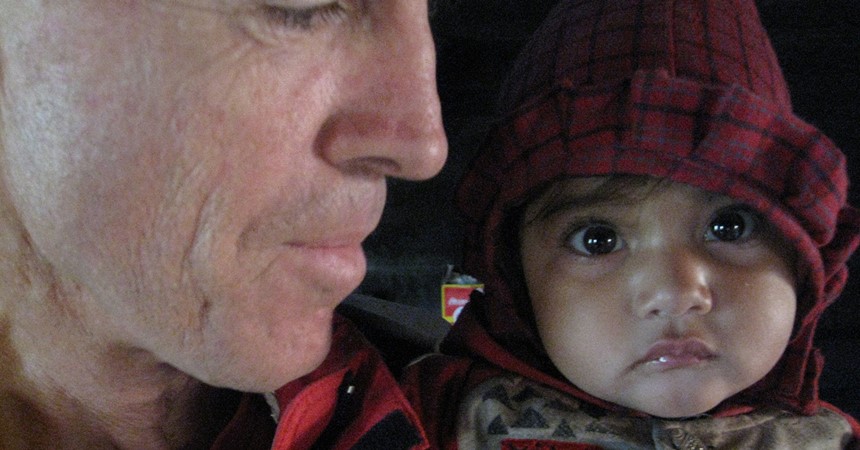Look into this child’s eyes. What do you see? Her name is Christina and I’m not sure today whether she’s dead or alive. This photo, of her in my arms, was taken four years ago in a remote Nepalese mountain village. It’s a gorgeous moment from a mystical trek I made with my wife, Julie and daughter, Eve to help install a solar light system in a health centre at an even more distant village.
Thoughts of that time were rudely dislodged six weeks ago when an earthquake rattled the very heart of Nepal. Thump after thump, media reports belted home details of the disaster. Even if Christina survived, too many others like her have not.
The extent of suffering in Nepal now and for the foreseeable future is beyond the comprehension of many of us basking in typical Australian luxury. Most of our community caught glimpses of the tragedy through graphic television footage, brief radio broadcasts and a few newspaper articles around 25 April, when a 7.8 magnitude quake devastated the capital city, Kathmandu, and smashed at least nine other districts.
But while those images may quickly fade, anyone who has been touched by the Nepalese, their culture and their country, will not forget. They tug in a way words cannot fully describe. Such gentle people with their respectful greeting of namaste (nah-mes-tay), spoken with a slight bow and hands pressed together pointing upward. A gesture that means ‘I bow to the divine in you’. Their civilisation, immersed in Hinduism and Buddhism, is reflected at every turn through meagre, daily offerings at footpath shrines, multicoloured prayer flags disintegrating in the breeze and majestic stupas (temples) perpetually overseeing all.
Then there are the contrasts, although this is just a hollow cliched word when trying to describe the fluctuating emotions that strike you when confronted by Kathmandu’s teeming masses, beggars lying in the open, domestic garbage piled in streets and clogging waterways, sacred cows and armed guards everywhere.
Next comes majestic mountain country. Stony, wriggling tracks climb to gnarled villages and tiny terraced farm plots somehow cling to rocks on the edge of the world, as crystal blue air swirls from deep green gorges and impossibly regal snowcapped peaks.
All this coexists in a poor economy with inadequacies and lack of resources in almost every area of human endeavour from government to water, sanitation and electricity supplies. And this is in the good times.
So, attempt to grasp the situation’s gravity now. In the wake of the earthquake, authorities stopped counting once they tallied almost 8,000 dead, about 17,000 injured and, at one stage, more than two million people displaced. Put that in perspective. The combined population of Greta and Branxton, near where I live, is about 6,000, and the entire Hunter population, including Lake Macquarie,Newcastle and everyone for more than 100 kilometres up the valley is about 800,000. Australia has fantastic emergency services and a fatal storm in the Hunter, a few days before the Nepali earthquake, saw wellresourced professional assistance flood in from numerous regions.
Meanwhile, much of Kathmandu remains rubble, numerous villages and rural communities are still shocked. At least 300,000 homes have been destroyed, several hundred thousand people are in need of basic shelter, food, water, clothing and medical supplies. People have been seriously destabilised, physically and psychologically. Yes, Australia was part of the international community that responded immediately to Nepal’s plight and began pouring in aid. Temporary tarpaulin camps and emergency help of all kinds arrived, but the April earthquake’s reality will impact for years. For instance, the next blow is about to land as the imminent monsoon season is expected to dump heavy rains throughout the country.
The Nepalese need much more than prayers.
When I think today about Nepal, I know it’s suffering a national disaster but I see individual people. I see the likes of Christina. And when I look into her eyes I see untainted innocence, beauty tinged with a strength that reaches back through generations and the light of a life so full of promise.
I know the Nepalese are a resilient lot and I hope we in the wealthy world continue to do all we can to support their reconstruction.
Namaste.
With news of a second major earthquake hitting Nepal on 12 May it is vital that we do all we can to support the Nepalese, now and into the future. You can do this by donating to the Caritas Nepal Earthquake Appeal by visiting www.caritas.org.au or please P 1800 024 413.






















































































